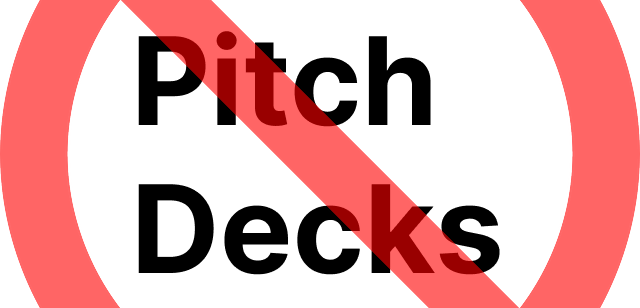
Written Memos vs Pitch Decks
According to Martin Tobias, the Founder/VC matching game is an incredibly low-probability game for BOTH sides (<1% chance of a “YES”). The trick to winning is to invest time and effort into situations where both have improved the odds.
My partner William recently published an essay preaching that, in order to improve the odds and save precious time, founders should send their pitch deck to investors before hopping on introductory calls or going for a coffee – a good practice yet often ignored by Latam founders.
I wholeheartedly agree with both Martin and William.
This article is intended for founders who understand the principles behind their advice and want to maximize your odds of success. By doing so, you can create time to run your company while fundraising and/or ensure you’re getting all the juice out of every VC opportunity that comes your way!
Jeff Bezos does not allow PowerPoint presentations at Amazon.
While he still reigned, Jeff Bezos famously banned the use of PowerPoint presentations in internal Amazon meetings. Instead, he instituted a company-wide policy that required employees to prepare written narratives, called “six-page memos,” to communicate their ideas and proposals.
First, he believed that traditional PowerPoint decks often lacked the depth and context necessary to fully understand a problem or idea. By forcing employees to write out their thoughts in a narrative format, he hoped to encourage more thoughtful analysis and fact-driven discussions.
Second, Bezos believed that the written memo format helped to level the playing field in meetings. With PowerPoint decks, those who were skilled at creating slick, visually appealing slides could often sway the discussion in their favor, even if their ideas weren’t the most sound. By requiring everyone to present their ideas in the same format, Bezos hoped to ensure that ideas were evaluated on their merits, rather than on the artistic skills of their creators.
Not surprisingly, the two reasons that influenced Bezos to adopt a written memo culture also apply to VC. Furthermore, it seems to have worked well for Amazon to decide how and where to invest their (and their investors’) resources.
Pros and cons of a written memo
Pros:
- A written memo provides greater depth and context: founders can go into greater detail about their ideas, providing investors with a deeper understanding of the business proposition, their market particularities, important but non-obvious differentiators and advantages etc.
- Encourages more thoughtful analysis: Writing out thoughts in a narrative format forces founders to think through their ideas more thoroughly and connect them accordingly. Once it’s successfully done, founders have the rare opportunity to literally guide their audience exactly through their train of thought and it’s a much better standalone format than a deck.
- The time invested in meetings and calls can be better used for useful discussions and deep-dive questions, rather than going through basic information that a presentation cannot adequately convey.
- More engaging: A well-written memo can be more engaging and interesting than a generic pitch deck, helping to hold investors’ attention and making a stronger impression amidst the dozens of PDF decks VCs receive each day.
- Poor design is a major distraction in decks. Achieving a good design sucks up too much time from the majority of founders I meet with. A written memo eliminates the need to spend time fussing with designing a beautiful deck. A Google Doc or Notion page is more than enough.
- Use VCs’ processes to your advantage: most VCs must write investment memos to circulate among their investment committee before making an investment decision. This means that by providing a well-written investment memo, you make it easier for the VC to do their job and increase your chances of success.
Cons:
- Memos require strong writing and narrative skills: Not all founders may be strong writers, which could make it challenging to craft a compelling and persuasive memo. (This can be a yellow flag in and of itself: as a company grows, more and more of its communication takes written form, and a winning founding team must master this skill rather sooner than later.)
- Less visually appealing: Memos are typically text-heavy (but shouldn’t!) and typically lack the visual appeal of a well-designed pitch deck (which is ok).
- May not fit all industries: While written memos can work well for some industries, they may not be the best format for others. For example, a b2c tech startup with a visually appealing product may benefit more from a pitch deck than a written memo.
- Some VCs may not have the time nor interest to read through your memo. I sincerely believe this will be the minority and those investors are specifically the ones that you’ll have a lower probability of winning anyway – this, if you really want this kind of lazy VC as a partner in your company for the next 10 years.
Anatomy of a great memo
- Start with a bullet-point TLDR containing the most important sections a pitch deck should contain.
- Pain you’re solving and market opportunity
- TAM (oh yeah, VCs love a big TAM to get them warmed up)
- Solution and value proposition
- Business model and revenue streams
- Competition and differentiation
- Traction and your most eye-catching metrics
- Team
- Milestones, timeline and much you’re raising to achieve them
Don’t you dare to force your readers to sift through thousands of words before you’ve got them intrigued and interested in you and your company!! This is still a sales pitch, but in written format.
- Go through all sections above a typical pitch presentation would contain:
- educate your readers on your the specificities of your market
- explain your moats, flywheels
- differentiators, etc
- Just because this is a written memo, that doesn’t mean you should ignore numbers. Quantify your points as much as possible. Use simple graphs to illustrate your data and pictures if you see fit.
Conclusion
Even if you’re not raising now, someday you might want to, or you might have a serendipitous encounter with the enchanted prince and I bet you won’t want him to go home empty-handed without an awe-inspiring material to study about your company.
Furthermore, attracting top talent is always hard. They always want to work with people they admire and whose vision is aligned with theirs. I bet your written memo will increase your conversion rates.
What’s keeping you from writing a compelling memo for your company?








March 14, 2023 at 3:25 pm
nothing special
March 14, 2023 at 10:09 am
Thanks, +